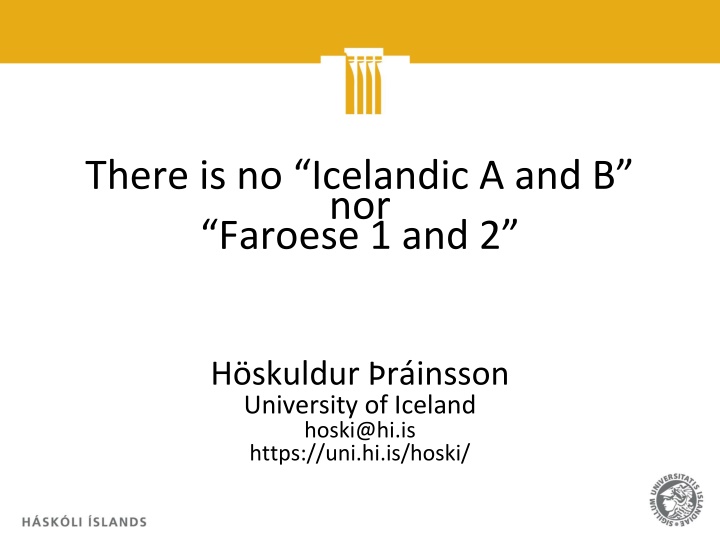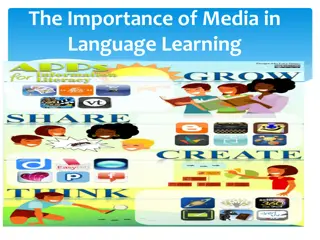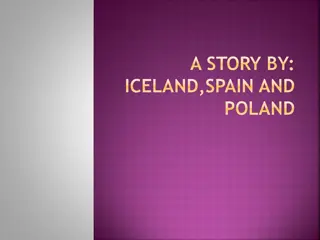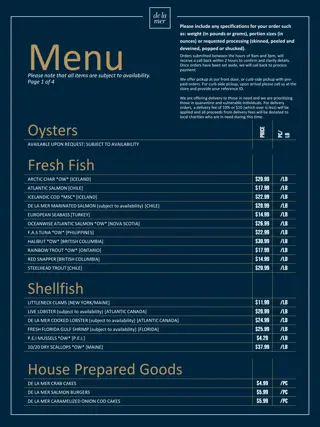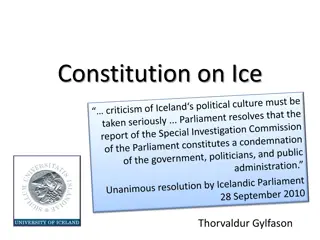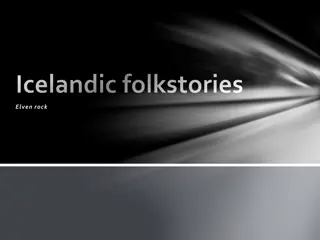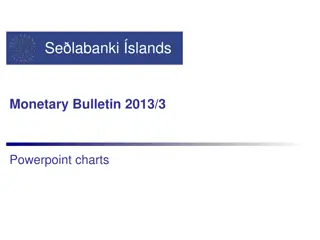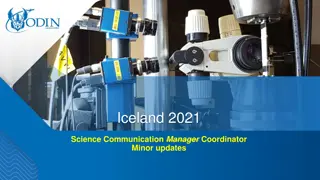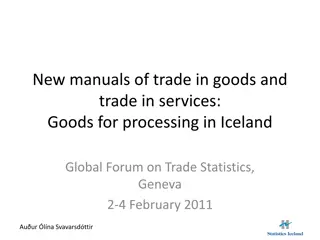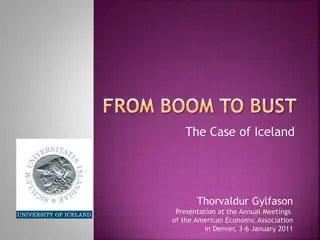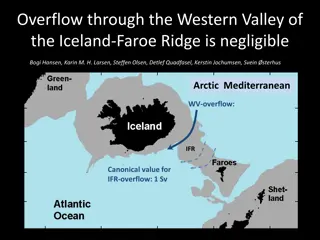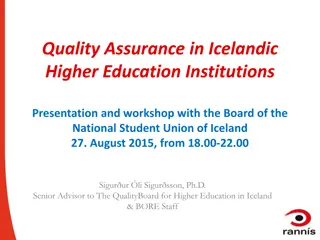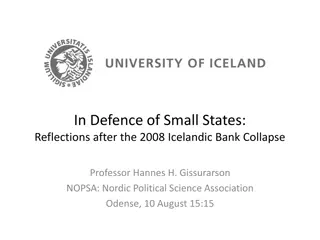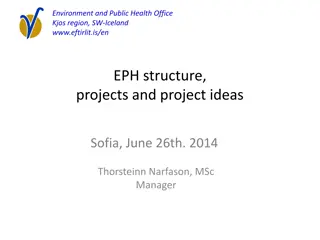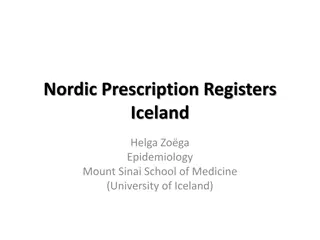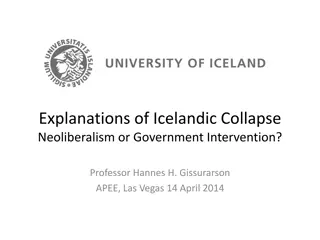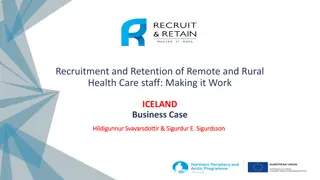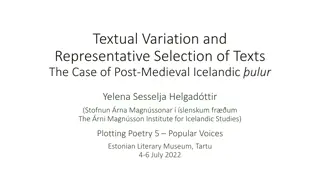Research on Icelandic and Faroese Language Contact at University of Iceland
Investigate the linguistic convergence between Icelandic and Faroese languages conducted by Hskuldur rnsson from the University of Iceland. For inquiries or more information, contact hoski@hi.is or visit https://uni.hi.is/hoski/.
Download Presentation

Please find below an Image/Link to download the presentation.
The content on the website is provided AS IS for your information and personal use only. It may not be sold, licensed, or shared on other websites without obtaining consent from the author.If you encounter any issues during the download, it is possible that the publisher has removed the file from their server.
You are allowed to download the files provided on this website for personal or commercial use, subject to the condition that they are used lawfully. All files are the property of their respective owners.
The content on the website is provided AS IS for your information and personal use only. It may not be sold, licensed, or shared on other websites without obtaining consent from the author.
E N D
Presentation Transcript
There is no Icelandic A and B nor Faroese 1 and 2 H skuldur r insson University of Iceland hoski@hi.is https://uni.hi.is/hoski/
Outline 1. 2. How can languages vary or do they? Icelandic A and B , Faroese 1 and 2 and similar ideas Examples of syntactic variation in Icelandic Examples of syntactic variation in Faroese Examples of phonological variation in Icelandic Naive falsificationist or is there an alternative? Conclusion 3. 4. 5. 6. 7. H skuldur r insson University of Iceland GLAC 22, Reykjav k, May 21, 2016 2
The nature and extent of linguistic variation Two diametrically opposed views: Human languages are very different: Many typologists and structuralists, most famously perhaps Joos (1957:96): languages can differ from each other without limit and in unpredictable ways (Joos 1957: 96). Human languages are all very similar even identical: Typical generativist position (UG), but also a view expressed by some structuralists and others: from certain points of view, there is only one human language [just as there is only one human heart ] this is not a new idea: Wilhelm von Humboldt held that the form of all languages must be fundamentally identical (Lightfoot 2006:3). H skuldur r insson University of Iceland GLAC 22, Reykjav k, May 21, 2016 3
The Logical Problem of Language Acquisition The question and the problem: How can most children come to know their native language very rapidly and in a fairly uniform fashion despite the so- called poverty of the stimulus: The input is supposedly both limited and at times inconsistent and misleading. This is a variant of Plato s Problem : "How come humans , whose contacts with the world are brief and personal and limited, are nevertheless able to know as much as they do?" The claim: Children learn infinitely more than they experience they acquire a productive grammar on the basis of very little experience. They are not simply mimicking what they hear around them. H skuldur r insson University of Iceland GLAC 22, Reykjav k, May 21, 2016 4
Principles and Parameters The Principles and Parameters (P&P) approach to the problem: The human brain comes prewired : We are born with a Universal Grammar which consists of: A finite set of fundamental principles that are common to all languages (and hence do not have to be learned). A finite set of parameters that determine and limit possible (syntactic) variability among languages. This accounts for the speed and uniformity of language acquisition: Acquiring a particular language (mainly) consists of setting the parameters. H skuldur r insson University of Iceland GLAC 22, Reykjav k, May 21, 2016 5
Acquiring a particular language The nature of acquisition a popular schematic presentation: Adult grammar (where the parameters have been set) Ss (steady state) UG (principles and unset parameters) S0 (initial state) + PLD (primary linguistic data) H skuldur r insson University of Iceland GLAC 22, Reykjav k, May 21, 2016 6
Important questions ... ... include the following (assuming parameters): How do children set the parameters? Do they do so quickly, e.g. on the basis of certain triggers , or does it take time? Are parameters necessarily strictly binary (+/-, 1/0, yes/no)? Is there a difference, in acquisition or in adult language, between parametric variation and other variation? What happens if there is variance in the PLD? How steady is the steady state? Studying linguistic variation may help answering some of these questions. H skuldur r insson University of Iceland GLAC 22, Reykjav k, May 21, 2016 7
Predictions made by the P&P approach If variation is typically parametric, we should find clear cross-linguistic differences that follow from different parametric settings. We might also find dialectal differences within a given language that can be defined in terms of different parametric settings. A famous example: Holmberg and Platzack s claim (1995) about the syntactic differences between Mainland Scandinavian (MSc, i.e. Danish, Norwegian, Swedish) and Insular Scandinavian (ISc, i.e. Old Norse, Icelandic, Faroese): Basically two parameters. H skuldur r insson University of Iceland GLAC 22, Reykjav k, May 21, 2016 8
Embedded Topicalization (ET) in Scandinavian Eir kur and H skuldur (1990): ET is fine in non-bridge verb complements in Icelandic: (1) a. J n efast um [a morgun fari Mar a snemma f tur] Jon doubts that tomorrow goes Mary early up. b. J n harmar [a essa b k skuli g hafa lesi ] Jon regrets that this book shall I have read John regrets that I read this book. but bad in MSc: (2) a. *Jon tvivlar p [att i morgon g r Maria upp tidigt] (Sw) John doubts that tomorrow goes Mary up early b. *John ngrar [att den h r boken l ste han] John regrets that this here book read he H skuldur r insson University of Iceland GLAC 22, Reykjav k, May 21, 2016 9
More on ET in Icelandic ET in adverbial clauses (examples and judgments from Fri rik Magn sson 1990): (3) a. g tla ekki a flytja til Reykjav kur [nema j r inaigeti g selt ei] I intend not to move to Reykjav k unless the farm can I sell. b. [Fyrst hur inaigetum vi ekki opna ei] ver um vi a brj ta gluggann. Since the door can we not open must we break the window. c. ?Sk li tlar a taka s r langt fr [ egar ritger inni ver ur hann b inn a skila] Skuli intends to take long break when the paper has he turned in. H skuldur r insson University of Iceland GLAC 22, Reykjav k, May 21, 2016 10
Icelandic A and B J hannes G sli finds Icelandic ET-examples like the ones in (1) and (3) bad and and made the following suggestion (1996:39, emphasis mine): For me, these examples are all equally bad. It seems then that there are basically two dialects with respect to embedded topicalization in Icelandic. Speakers of the more liberal dialect, which I will call dialect A, allow topicalization quite freely in embedded clauses apart from temporal clauses [and relative clauses and embedded questions]. By contrast, speakers of the more conservative dialect (henceforth, dialect B) allow embedded topicalization only in the complements of bridge verb[s as does Mainland Scandinavian]. H skuldur r insson University of Iceland GLAC 22, Reykjav k, May 21, 2016 11
Assumed speakers of Icelandic A and B At least the following, when J hannes wrote his dissertation (1996, pictures from Facebook): Icelandic A: Icelandic B: H skuldur r insson University of Iceland GLAC 22, Reykjav k, May 21, 2016 12
ET and the classification of embedded clauses Some points: Embedded questions and relative clauses are special. We probably need a more detailed classification of adverbial clauses (cf. sgr mur and Dianne Jonas later today). The classification of that -clauses into bridge-verb and non-bridge-verb complements is probably too crude and we probably need something like this, where complements of C and D are least main-clause-like (cf. Hooper and Thomson 1973, see also sgr mur 2011): A, strongly assertive: say , claim B, weakly assertive: believe, think C, non-assertive:deny, doubt D, factive emotive: regret, be sad about E, semi-factive: discover, understand H skuldur r insson University of Iceland GLAC 22, Reykjav k, May 21, 2016 13
Looking for Icelandic A and B Wiklund et al. (2009) consulted six Icelandic speaking linguists asking for judgments of ET in that-complements of types A E (cf. preceding slide). All accepted ET in comple- ments of A, B and E-type verbs but disagreed about C and D: 1 2 3 4 5 6 Does 1 3 represent Icelandic B and 4 6 Icelandic A? H skuldur r insson University of Iceland GLAC 22, Reykjav k, May 21, 2016 14
Still looking ... Gunnar Hrafn and Anna-Lena Wiklund did some more work on this (2009, 2010) and made the following claims among others: Maybe there is no Icelandic A or no generalized V2 languages (in the sense of Vikner 1995 and others). There are just langugages with extended V2 . All speakers of Icelandic reject some instances of ET but they are more liberal in accepting ET than speakers of MSc. So maybe there is a parameter distinguishing Isc from MSc an Agr-related parameter in the sense of Holmberg (2010). ( sgr mur (2011) finds very little evidence for this.) H skuldur r insson University of Iceland GLAC 22, Reykjav k, May 21, 2016 15
... and looking Heycock, Sorace and Hansen 2010: 35 speakers of Icelandic (14m, 21f) Systematic comprison of a large number of sentences (also in Faroese and Danish) ET in complements of bridge verbs (strongly assertive say ) and two types of non-bridge verbs (factive regret , admit ; non- assertive doubt , deny ) and indirect questions. Used magnitude estimation (the subjects set their own scale for comparing the sentences) rather than choice between three or more predefined classes. All instances of ET involved fronting of adjuncts, not arguments. H skuldur Thr insson: Icelandic A,B,C,D ...? 25. Februar 2011 16
Heycock et al. on ET in Icelandic Although there was considerable variation in the judgments of the Icelandic speakers w.r.t. ET, there is no evidence for a clear IcelA vs. IcelB split (a bimodal grouping): H skuldur Thr insson: Icelandic A,B,C,D ...? 25. Februar 2011 17
Possible counterargument Devil s advocate: Well, I don t really understand this graph from Heycock et al. I m a bit confused about this magnitude estimation -thing and maybe some of the subjects were too. Reply: OK, so let s look even more closely ... H skuldur r insson University of Iceland GLAC 22, Reykjav k, May 21, 2016 18
Looking more closely ... IceDiaSyn (Icelandic Dialect Syntax) 2005 2008 (part of the network ScanDiaSyn, cf. Tilbrig i slenskri setningager I III): Method and subjects: Main method: Written questionnaires: mostly judgments ... but also forced choice between alternatives, fill-ins. Structured interviews with some of the subjects a few months later. Comparison with corpora in some instances (cf. sta Svavarsd ttir 2013). 3x720+ subjects, four age groups (15, 20 25, 40 45, 65 70), aiming for 8 from each group, approx. 25 locations each time. H skuldur r insson University of Iceland GLAC 22, Reykjav k, May 21, 2016 19
IceDiaSyn, 2 Typical format of the written questionnaire: Context sentences. Three alternatives. Short passage read to the participants explaining the nature and purpose of the task. H skuldur r insson University of Iceland GLAC 22, Reykjav k, May 21, 2016 20
IceDiaSyn, 3 Locations visited in IceDiaSyn: H skuldur r insson University of Iceland GLAC 22, Reykjav k, May 21, 2016 21
ET in C- and D-complements Examples from IceDiaSyn (see H skuldur, sgr mur and Heimir Freyr 2015): (5) a. Mar a hefur hitt marga af starfsm nnunum. g efast samt um [ a ennan mann hafi h n hitt] Mary has met many of the employees. Yet I doubt that this man has she met. b. Borgarfulltr arnir r ddu ekki m lefni aldra ra. R herrann harmar [a a m l skuli eir ekki hafa r tt] The city council members didn t discuss matters of the elderly . The minister regrets that this issue didn t they discuss. (5a) = type C: non-assertive (5b) = type D: factive emotive GLAC 22, Reykjav k, May 21, 2016 H skuldur r insson University of Iceland 22
Evidence for Icelandic A and B? Results from the IceDiaSyn questionnaire: 1,00 = accepts both (= Icel. A?) 3,00 = rejects both (= Icel. B?) The rest = ? GLAC 22, Reykjav k, May 21, 2016 H skuldur r insson University of Iceland 23
Possible counterargument Devil s Advocate: Well, Topicalization is difficult to deal with using questionnaires. It depends heavily on discourse factors. Hence speakers may not find grammatical examples completely acceptable and even reject them for the wrong reason. Reply: That shouldn t affect the answers of speakers of Icelandic B we should get even more Icelandic-B-like answers. But let s look at something different anyway, e.g. Dative Substitution ( Dative Sickness ). Presumably immune to discourse factors. H skuldur r insson University of Iceland GLAC 22, Reykjav k, May 21, 2016 24
Dative Substitution Examples from IceDiaSyn the most typical DS-verbs (cf. H skuldur, rhallur, sta and runn 2015 w. refs.): (6) a. Margir fara rsh t febr ar. Okkur orvaldi langar til a fara orrabl t. Many go to an annual celebration in February. Me(A/D) and Thorvald(D) want to go to orrabl t. b. Helgi er a fara tilegu. Str kunum langar a fara me honum. Helgi is going camping. The boys(D) want to go with him. c. g hitti bankastj rann afgrei slunni. Hann spur i hvort m r vanta i ekki l n. I met the bank director in the counter. He asked if me(D) didn t need a loan. d. Gu n er a leita a afm lisgj f handa Dav . H n heldur a honum vanti annan s ma. Gudny is looking for a birthday present for David. She thinks him(D) needs another phone. GLAC 22, Reykjav k, May 21, 2016 H skuldur r insson University of Iceland 25
Results from IceDiaSyn Acceptance of DS: 1,00 = Accepts all, 3,00 = Rejects all GLAC 22, Reykjav k, May 21, 2016 H skuldur r insson University of Iceland 26
Possible counterargument Devil s advocate: Well, this is just judgments in a written questionnaire. It may not reflect actual usage . Reply: There is no reason to expect that actual usage reflects the underlying grammar better than judgments do. Results from questionnaires correspond fairly well to results obtained from corpora (cf. sta 2015). Variation between Dat and Acc with verbs of this kind is also found in production (cf. Iris Edda 2012, 2014a, 2014b; J hannes G sli $$). Consider results from the fill-in method in IceDiaSyn. H skuldur r insson University of Iceland GLAC 22, Reykjav k, May 21, 2016 27
The fill-in examples with langa and vanta (7) a. Rakel er mj g spennt [...] ______ langar ekkert til a la fer inni. Rachel is very excited ... ______ wants not to throw up on the trip. b. s r h n a ______ vantar gemsann sinn. Then she sees that ______ lacks her cell phone. Instructions: This is a story about Rachel and her dad. Fill in the blanks with the pronominal forms h n/hana/henni/hennar or hann/honum/hans as illustrated in the examples below. [The forms suggested are N/A/D/G fem. and masc.] GLAC 22, Reykjav k, May 21, 2016 H skuldur r insson University of Iceland 28
More results from IceDiaSyn Results for the two fill-in-examples w. langa want and vanta lack, need : 1,00 = selected Dat for both examples 3,00 = selected Acc for both examples 2,00 = selected Dat for one and Acc for the other GLAC 22, Reykjav k, May 21, 2016 H skuldur r insson University of Iceland 29
Intra-speaker variation in naturalistic data Examples from Iris Edda (2014b): (8) mig vantar iPhone [...] m r vantar svona t ki [...] m r vantar s ma me(Acc) needs iPhone ... me(Dat) needs this gadget ... me(Dat) needs phone [Written on a discussion board within a period of 5 minutes.] But many speakers are more likely to accept and use Dat with 3rd person subjects than with 1st and 2nd person subjects, and this even holds for young children and speakers of North American Icelandic (Iris Edda 2012, 2014a). H skuldur r insson University of Iceland GLAC 22, Reykjav k, May 21, 2016 30
Possible counterargument Devil s advocate: Well, Dative Substitution is probably not representative of a parametric. If one looks at truly parametric variation, then one will find clear-cut division between languages and/or dialects. Reply: It is true that Holmberg and Platzack just assumed that the possibility of having non-nominative subjects might be due to a parametric difference (ISc vs. MSc) they didn t say anything about Dative Substitution. But let s turn to Faroese, then ... H skuldur r insson University of Iceland GLAC 22, Reykjav k, May 21, 2016 31
Verb placement in Faroese Some claims about Faroese syntax: It is, or at least should be, like Icelandic, namely a true ISc language (Holmberg and Platzack 1995). It is actually more like MSc (Vikner 1995). There is ISc-like Faroese 1 and MSc-like Faroese 2 (Jonas 1996, cf. also 2002), e.g. with respect to V-to-I. H skuldur r insson University of Iceland GLAC 22, Reykjav k, May 21, 2016 32
Hskuldur rinsson University of Iceland GLAC 22, Reykjav k, May 21, 2016 33
References, 2 Hale, Mark. 2007. Historical Linguistics: Theory and Method. Blackwell, Oxford. Halld r rmann Sigur sson. 1989. Verbal Syntax and Case in Icelandic in a Comparative GB Approach. Doctoral dissertation, University of Lund, Lund. H skuldur Thr insson. 2007. The Syntax of Icelandic. Cambridge University Press, Cambridge. GLAC 22, Reykjav k, May 21, 2016 H skuldur r insson University of Iceland 34
References, 3 Kroch, Anthony S. 1989. Reflexes of grammar in patterns of language change. Language Variation and Change 1:199 244. Kroch, Anthony S. 2001. Syntactic Change. In Mark Baltin and Chris Collins (eds.): The Handbook of Contemporary Syntactic Theory, pp. 699 729. Labov, William. 2001. Principles of Linguistic Change. Volume II: Social Factors. Blackwell, Oxford. Labov, William, and Wendell A Harris. 1986. De Facto Segregation of Black and White Vernaculars. In David Sankoff (ed.): Diversity and Diachrony, pp. 1 24. Benjamins, Amsterdam. Yang, Charles. 2002. Knowledge and Learning in Natural Language. Oxford University Press, Oxford. GLAC 22, Reykjav k, May 21, 2016 H skuldur r insson University of Iceland 35
Angantsson, sgrmur. 2007. Verb-third in embedded clauses in Icelandic. Studia Linguistica 61:237 260. Angant sson, sgr mur. 2011. The Syntax of Embedded Clauses in Icelandic and Related Languages. Doctoral dissertation, University of Iceland, Reykjav k. rnason, Kristj n, and H skuldur Thr insson. 2003. Fonologiske dialekttr k p Island. Gunnstein Akselberg, Anne Marit B dal and Helge Sand y (eds): Nordisk dialektologi, pp. 151 196. Novus, Oslo. G rtner, Hans-Martin. 2003. How Icelandic can you be, if you speak Icelandic B? Grammar in Focus II, pp. 115 122. Festschrift for Christer Platzack 18 November 2003. Lund University, Lund. Heycock, Caroline, Antonella Sorace and Zakaris Svabo Hansen. 2010. V-to-I and V2 in subordinate clauses: an investigation of Faroese in relation to Icelandic and Danish. Journal of Comparative Germanic Syntax 13:61 97. H skuldur r insson University of Iceland GLAC 22, Reykjav k, May 21, 2016 36
Holmberg, Anders. 2010. Parameters in minimalist theory: The case of Scandinavian. Theoretical Linguistics 36:1 48. Holmberg, Anders, and Christer Platzack. 1995. The Role of Inflection in Scandinavian Syntax. Oxford University Press, Oxford. Hooper, Joan B., and Sandra A. Thompson. 1973. On the applicability of root transformations. Linguistic Inquiry 4:465 497. Henry, Alison. 1995. Belfast English and Standard English: Dialect Variation and Parameter Setting. Oxford University Press, Oxford. Henry, Alison. 2005a. Idiolectal Variation and Syntactic Theory. In Leonie Cornips and Karen P. Corrigan (eds.): Syntax and Variation: Reconciling the Biological and the Social, pp. 109 122. John Benjamins, Amsterdam. Henry, Alison. 2005b. Non-standard Dialects and Linguistic Data. Lingua 115:1599 1617. H skuldur r insson University of Iceland GLAC 22, Reykjav k, May 21, 2016 37
Hrafnbjargarson, Gunnar Hrafn, and Anna-Lena Wiklund. 2009. General Embedded V2: Icelandic A, B, C, etc. WPSS 84:21 51. Hrafnbjargarson, Gunnar Hrafn, and Anna-Lena Wiklund. 2010. Agr and V2. Theoretical Linguistics 36:57 68. Hrafnbjargarson, Gunnar Hrafn, Kristine Bentzen and Anna-Lena Wiklund. 2010. Observations on extraction from V2 clauses. Nordic Journal of Linguistics 33:299 309. Jonas, Dianne. 1996. Jonas, Dianne. 2002. Residual V-to-I. Joos, Martin. 1957. Readings in Linguistics: The Development of Descriptive Linguistics in America since 1925. American Council of Learned Societies, Washington DC. H skuldur r insson University of Iceland GLAC 22, Reykjav k, May 21, 2016 38
Jnsson, Jhannes Gsli. 1991. Stylistic Fronting in Icelandic. WPSS 48:144. J nsson, J hannes G sli. 1996. Clausal Architecture and Case in Icelandic. Doctoral dissertation, University of Massachusetts, Amherst. J nsson, J hannes G sli, and Th rhallur Eyth rsson. 2005. Variation and change in subject case marking in Insular Scandinavian. Nordic Journal of Linguistics 28(2):223 245. Kroch, Anthony S. 2001. Syntactic Change. In Mark Baltin and Chris Collins (eds): The Handbook of Contemporary Syntactic Theory, pp. 699 729. Blacwell, Oxford. Lightfoot, David. 2006. How New Languages Emerge. Cambridge University Press, Cambridge. H skuldur r insson University of Iceland GLAC 22, Reykjav k, May 21, 2016 39
Magnsson, Fririk. 1990. Kjarnafrsla og a-innskot aukasetningum slensku. [Topicalization and there-insertion in embedded clauses in Icelandic.] M lv sindastofnun H sk la slands, Reykjav k. Maling, Joan. 1980. Inversion in embedded Clauses in Modern Icelandic. slenskt m l 2, 175-193. [Also in Maling and Zaenen (eds) 1990.] Maling, Joan, and Annie Zaenen (eds). 1990. Modern Icelandic Syntax. Syntax and Semantics 24. Academic Press, San Diego. Newmeyer, Fritz. 2004. Against a parameter-setting approach to language variation. Language Variation Yearbook 4:181 234. R gnvaldsson, Eir kur. 1984. Icelandic Word Order and a -Insertion. WPSS 8. R gnvaldsson, Eir kur, and H skuldur Thr insson. 1990. On Icelandic Word Order Once More. Joan Maling and Annie Zaenen (eds), pp. 3 40. H skuldur r insson University of Iceland GLAC 22, Reykjav k, May 21, 2016 40
Schtze, Carson T. 1996. The Empirical Base of Linguistics: Grammatical Judgments and Linguistic Methodology. U. of Chicago Press, Chicago. Sigur sson, Halld r rmann. 1990. Long-Distance Reflexives and Moods in Icelandic. Joan Maling and Annie Zaenen (eds), pp. 309 346. Thr insson, H skuldur. 1984. Some Points on Icelandic Word Order. WPSS 8. Thr insson, H skuldur. 2001. Syntactic Theory for Faroese and Faroese for Syntactic Theory. Kurt Braunm ller and J gvan Lon Jacobsen (eds): Moderne lingvistiske teorier og f r sk, pp. 89 124. Thr insson, H skuldur. 2007. The Syntax of Icelandic. Cambridge UP, Cambridge. Thr insson, H skuldur. 2010a. Predictable and unpredictable sources of variable verb and adverb placement in Scandinavian. Lingua 120, 5:1062- 1088. Thr insson, H skuldur. 2010b. Ideal speakers and other speakers. The case of dative and some other cases. Ms., University of Iceland, Reykjav k. GLAC 22, Reykjav k, May 21, 2016 H skuldur r insson University of Iceland 41
Thrinsson, Hskuldur, Hjalmar Petersen, Jgvan Lon Jacobsen and Zakaris Svabo Hansen. 2004. Faroese: An Overview and Reference Grammar Vikner, Sten. 1995. Verb Movement and Expletive Subjects in the Germanic Languages. Oxford University Press, Oxford. Wiklund, Anna-Lena, Kristine Bentzen, Gunnar Hrafn Hrafnbjargarson and orbj rg Hr arsd ttir. 2009. On the distribution and illocution of V2 in Scandinavian that-clauses. Lingua 119:1914 1938. Yang, Charles. 2010. Three factors in language variation. Lingua 120, 5:1160- 1177. H skuldur r insson University of Iceland GLAC 22, Reykjav k, May 21, 2016 42
